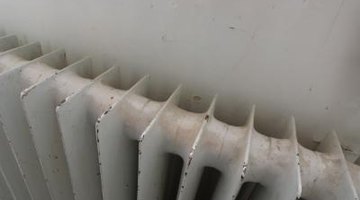How to Make Infrared Panels
Infrared is the most convenient method of transferring heat. There are three ways in which heat is transferred: conduction, convection and radiation. Conduction occurs only when two different-temperature objects come in contact with each other. Convection happens when heated air moves, but air doesn't transfer very much heat to objects. So the most effective choice for heating for many different situations is infrared radiation. There are dozens of ways in which different styles of infrared heaters can be combined to create an integrated infrared heating panel. One particular example will showcase the design principles.

Step 1
Select a style of infrared filament that fits your application. The peak wavelength corresponds to the temperature --- shorter wavelengths being higher temperatures. As an example, for a sauna heater panel, you could select a ceramic-emitter filament emitting a peak wavelength about 8.5 micrometers, which corresponds to a temperature of about 150 degrees Fahrenheit.
Step 2
Lay out the emitters to evenly cover the area you want to heat. The emitter manufacturer will provide radiation patterns. For example, a ceramic emitter might have an emission pattern that spreads out 1 inch for every 6 inches of distance. The sauna could have the infrared panel 1 foot away from the area to be evenly heated, so neighboring emitters can be spaced 4 inches apart and still evenly heat the area.
Step 3
Cut holes in the sheet metal to feed the mounting bracket and leads from the heaters. Put the emitter mounting brackets through the sheet metal and attach them. The style of mounting will depend on your choice of emitter.
Step 4
Place the refractory blocks on the back side of the mounting plate, fitting them around the leads from the emitters. Hold them in place with the brackets. The refractory blocks are to serve as insulators and can be held in place in many different ways, including just attaching another piece of sheet metal to make a 'sandwich' construction with the leads coming out the back.
Step 5
Trim and seal the edges of the panel with the L-bracket or U-channel or equivalent material. If your panel is very large, put some cross-members across the face and back of the panel to provide structural support.
Step 6
Connect the leads in series and connect to the power supply via the potentiometer. The series connection will ensure the same current gets sent through each emitter.
References
Resources
Tips
- It's not a bad idea to use an emitter filament that is rated for a higher temperature than you need, but your cost and the physical size of the emitter will go up as well.
Warnings
- It's a good idea to set a safety limit on your potentiometer so the panel does not overheat. Set the panel to the maximum safe temperature --- make sure to wait for the filaments to come up to temperature to check --- and put a mechanical stop on your potentiometer to ensure the temperature does not get too high. Depending upon the physical location of your panel, you may want to build a physical barrier, such as a wire mesh screen, in front of the panel to be sure people don't touch the heated elements.
Writer Bio
First published in 1998, Richard Gaughan has contributed to publications such as "Photonics Spectra," "The Scientist" and other magazines. He is the author of "Accidental Genius: The World's Greatest By-Chance Discoveries." Gaughan holds a Bachelor of Science in physics from the University of Chicago.
Photo Credits
- Jupiterimages/Photos.com/Getty Images
More Articles



